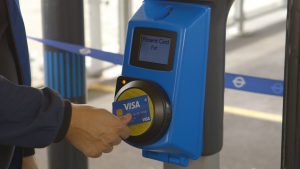North America’s largest payments company on Thursday said it expects to receive a $1 billion bonus from the federal tax-reform bill passed into law in December. In contrast with its rival Mastercard Inc., which reported earlier in the day it recorded an $873 million charge in the fourth quarter related to the new tax law, Visa Inc. told stock analysts it expects about 8 additional percentage points of growth in earnings per share this year and next from the reduction in the corporate tax rate from 35% to 21% mandated by the new Tax Cuts and Jobs Act.
“That’s a $1 billion benefit to us in lower taxes,” Vasant Prabhu, Visa’s chief financial officer, said during a conference call to discuss results for the last three months of 2017, which is Visa’s fiscal first quarter for 2018.
Without giving specifics, Prabhu and chief executive Alfred Kelly said Visa will invest the windfall in a wide range of new and existing initiatives. “Our priority is to invest in our business. Lower tax rates make investments more attractive,” said Prabhu.
Visa’s top brass also celebrated progress toward contactless transactions in the United States while indicating they still see a role for signature authentication. By the end of the year, about half of the installed base of U.S. point-of-sale terminals will be capable of processing contactless payments using near-field communication, Kelly said, adding, “virtually every terminal shipped now is contactless.” As a result, he said, “the plumbing is in place to go contactless” in the U.S., a development he said Visa has encouraged with the advent of EMV chip technology.

Many observers favor contactless as a faster and smoother routine for chip-based transactions, but issuers have been reluctant to add contactless technology to their cards because of the added expense of so-called dual-interface capability for contact and contactless payments. Kelly, though, predicted that reluctance won’t last. “This is a multiyear journey,” he told the analysts. “[As] issuers go through their normal replacement cycle, more and more of those cards will be NFC-enabled.”
Visa was the last of the major card networks to make signatures optional with EMV contact and contactless transactions in North America, and while Kelly didn’t back away from that decision, he said, “I still think there’s a place for signatures. We expect merchants in certain situations will want to continue asking for a signature.” Such situations, he said, could include high-value payments as well as tipping, where customers will want to make sure not to sign until the tip has already been added. In any case, Kelly said, “the majority of transactions in the U.S. didn’t require a signature any way” because of dollar limits.
For the quarter, U.S. payments volume increased nearly 10% year-over-year, to $881 billion, while worldwide volume grew just over 12% to exceed $2 trillion. U.S. credit card volume reached $478 billion, up 11%, while U.S. debit payments totaled $402 billion, a 7.5% jump.
Processed transactions, which are payments on cards with Visa brands processed on Visa’s networks, totaled 30.5 billion for the quarter, up 12% year over year. Worldwide cards in circulation for the quarter ended Sept. 30 reached 3.21 billion, a 4% increase. Of these, 1.07 billion were credit cards, virtually unchanged year-over-year, and 2.14 billion were debit cards, up 6%.
Revenue net of client incentives for the Dec. 31 quarter totaled $4.86 billion, up 9% year-over-year. Client incentives climbed 27%, to $1.33 billion, or 21.4% of gross revenues, up from 18.9% a year earlier.





